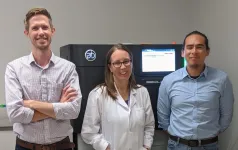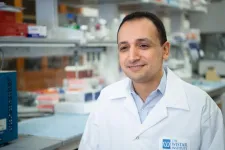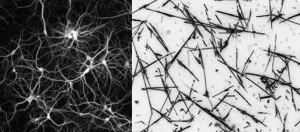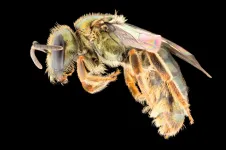The final dance of mixed neutron star-black hole pairs
2021-06-29
(Press-News.org) Gravitational wave detectors have observed a new type of cataclysmic event in the cosmos: the merger of a neutron star with a black hole.
The phenomenon was detected twice in January 2020.
Several hypotheses could explain the existence of such mixed pairs. Further observations will be needed in order to settle the question.
Another missing piece has just been added to our knowledge of cosmic phenomena. The LIGO, Virgo and KAGRA collaborations have announced the first detection of gravitational waves (1) resulting from the 'mixed' merger between a black hole and a neutron star (2). The discovery, published on June 29, 2021 in Astrophysical Journal Letters, involves CNRS researchers working within the Virgo scientific collaboration.
Although it has only been only a few years since the very first observation of gravitational waves, the technique has yielded an extensive repertoire of phenomena involving massive cosmic objects. The LIGO and Virgo detectors have already observed mergers of pairs (or binaries) of black holes and, less frequently, of neutron stars. However, gravitational waves detected in January 2020 provide evidence of the existence of a new type of system. The signals, named GW200105 and GW200115 from their dates of detection, were produced by a process that had been predicted but never observed until now: the coalescence of 'mixed pairs' called NSBH pairs, each made up of a neutron star and a black hole (3).
Gravitational waves contain valuable information about their source, such as the mass of the components making up the binary. Analysis of the signals revealed that GW200105 resulted from the merger, some 900 million years ago, of a black hole and a neutron star, respectively 8.9 times and 1.9 times more massive than the Sun, while GW200115 originated from an NSBH pair which coalesced around 1 billion years ago, with masses 5.7 and 1.5 times greater than the Sun. The difference in mass between the components of the system indicates that they are indeed mixed binaries: the mass of the heavier object corresponds to that of a black hole while the mass of the lighter object is consistent with that of a neutron star. The difference between the two masses could also explain why no light signals were detected by telescopes. When a neutron star approaches a black hole it can theoretically be torn apart by tidal forces, causing flares of electromagnetic radiation. However, in the two cases observed, the black hole, being much more massive, could have gobbled up the neutron star in a single mouthful, leaving no trace.
Several hypotheses have been proposed to explain the formation of mixed NSBH binaries. The first involves the evolution of a pair of stars in orbit around one another. Towards the end of their lives, one of the stars could become a black hole and the other a neutron star, while still rotating around each other. According to another hypothesis, that of dynamic interaction, the two components of the pair form independently in a very dense stellar medium before coming together. These results open up the way for the detection of other mixed binaries, as well as for the observation and understanding of extreme phenomena of a similar nature.
INFORMATION:
Notes
(1) Gravitational waves are tiny ripples in space-time and were first observed in 2015, a century after Albert Einstein predicted their existence in his General Theory of Relativity.
(2) A neutron star is the residue of the collapse of a massive star at the end of its life.
(3) The two signals have different confidence levels. Although the statistical significance of GW200105 is not very high, the shape of the signal and the parameters inferred from it point to an astrophysical origin.
About Virgo, LIGO and KAGRA
The Virgo Collaboration is currently composed of approximately 690 members from 15 countries. The European Gravitational Observatory (EGO) hosts the Virgo detector near Pisa in Italy, and is funded by the French National Centre for Scientific Research (CNRS) in France, the Istituto Nazionale di Fisica Nucleare (INFN) in Italy, and Nikhef in the Netherlands. A list of the Virgo Collaboration groups can be found at http://public.virgo-gw.eu/the-virgo-collaboration.
LIGO is funded by the National Science Foundation (NSF) and operated by Caltech and MIT, which conceived of LIGO and led the project. Financial support for the Advanced LIGO project was led by the NSF, with Germany (Max Planck Society), the UK (Science and Technology Facilities Council) and Australia (Australian Research Council-OzGrav) making significant commitments and contributions to the project. Approximately 1,300 scientists from around the world participate in the effort through the LIGO Scientific Collaboration, which includes the GEO Collaboration. A list of additional partners is available at https://my.ligo.org/census.php.
The KAGRA laser interferometer is located in Kamioka, Japan. The host institute is the Institute of Cosmic Ray Researches (ICRR) at the University of Tokyo, and the project is co-hosted by National Astronomical Observatory in Japan (NAOJ) and High Energy Accelerator Research Organization (KEK). KAGRA completed its construction in 2019 and the data taking started in February 2020 during the final stage of the run called "O3b." KAGRA Scientific Congress is composed of over 470 members from 14 countries/regions. See: https://gwwiki.icrr.u-tokyo.ac.jp/JGWwiki/KAGRA/KSC/Researchers
The scientific article announcing this discovery is co-signed by 102 scientists in France, working in eight teams from the CNRS and associated universities, part of the Virgo Collaboration:
'Astroparticule et cosmologie' laboratory (CNRS/Université de Paris) ;
Artemis laboratory (CNRS/Observatoire de la Côte d'Azur/Université Côte d'Azur) ;
g-MAG team, with scientists from the 'Institut lumière matière' (CNRS/Université Claude Bernard Lyon 1), the 'Institut des nanotechnologies de Lyon' (CNRS/Ecole Centrale de Lyon/INSA Lyon/Université Claude Bernard Lyon 1/CPE Lyon), the 'Institut des nanosciences de Paris' (CNRS/Sorbonne Université) and the Navier laboratory (CNRS/École des Ponts ParisTech/ Université Gustave Eiffel) ;
'Institut de physique des 2 infinis de Lyon' (CNRS/Université Claude Bernard Lyon 1) ;
'Institut pluridisciplinaire Hubert Curien' (CNRS/Université de Strasbourg) ;
'Laboratoire d'Annecy de physique des particules' (CNRS/Université Savoie Mont Blanc) ;
'Laboratoire Kastler Brossel' (CNRS/Sorbonne Université/ENS-PSL/Collège de France) ;
'Laboratoire de physique des 2 infinis - Irène Joliot-Curie' (CNRS/Université Paris-Saclay).
Some of the authors are associated with the teams mentionned above while working in other laboratories: 'Institut Foton' (CNRS/Université Rennes 1/Insa Rennes), Lagrange laboratory (CNRS/Université Côte d'Azur/Observatoire Côte d'Azur), 'Laboratoire de physique et d'étude des matériaux' (CNRS/Sorbonne Université/ESPCI Paris).
[Attachments] See images for this press release:
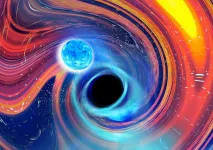
ELSE PRESS RELEASES FROM THIS DATE:
2021-06-29
LOUISVILLE, Ky. - Historically, most large-scale immunogenomic studies - those exploring the association between genes and disease - were conducted with a bias toward individuals of European ancestry. Corey T. Watson, Ph.D., assistant professor in the University of Louisville Department of Biochemistry and Molecular Genetics, is leading a call to actively diversify the genetic resources he and fellow immunogenomics researchers use in their work to advance genomic medicine more equitably.
Watson, along with UofL post-doctoral fellow Oscar Rodriguez, Ph.D., and visiting fellow Yana Safonova, Ph.D., are part of an international group of researchers ...
2021-06-29
PHILADELPHIA -- (June 29, 2021) -- New biomarkers that predict HIV remission after antiretroviral therapy (ART) interruption are critical for the development of new therapeutic strategies that can achieve infection control without ART, a condition defined as functional cure. These biomarkers can also provide critical clues into the biological mechanisms that control HIV replication after stopping therapy, and can help design novel strategies to cure HIV. Scientists at The Wistar Institute have identified metabolic and glycomic signatures in the blood of a rare population of HIV-infected individuals who can naturally sustain viral suppression after ART cessation, known as post-treatment controllers. These findings were published in Nature ...
2021-06-29
Scientists at the University of Sydney and Japan's National Institute for Material Science (NIMS) have discovered that an artificial network of nanowires can be tuned to respond in a brain-like way when electrically stimulated.
The international team, led by Joel Hochstetter with Professor Zdenka Kuncic and Professor Tomonobu Nakayama, found that by keeping the network of nanowires in a brain-like state "at the edge of chaos", it performed tasks at an optimal level.
This, they say, suggests the underlying nature of neural intelligence is physical, and their discovery opens an exciting avenue for the development of artificial intelligence.
The study is published today in Nature Communications.
"We used wires 10 micrometres long and no thicker than 500 nanometres ...
2021-06-29
Researchers from Queen Mary University of London have identified a protein that could be used to aid in the diagnosis of pancreatic cancer.
Findings from the new study suggest that a protein called pentraxin 3 (PTX3) may be a specific diagnostic biomarker - or biological measure - for pancreatic cancer, with the ability to differentiate pancreatic cancer from other non-cancerous conditions of the pancreas.
The research was published today in npj Precision Oncology, and primarily funded by the Pancreatic Cancer Research Fund, Barts Charity and Cancer Research UK.
PTX3 levels elevated in patients with pancreatic ...
2021-06-29
This press release is in support of a presentation by Dr Maria Cerrillo Martinez presented online at the 37th Annual Meeting of ESHRE.
29 June 2021: Fertility patients who have a poor response to ovarian stimulation represent a stubborn challenge in IVF. Few eggs are collected, success rates are low, and several treatments are usually needed to achieve pregnancy (if at all). Clinical guidelines indicate that increasing the drug dose for stimulation or applying any of several adjunct therapies are of little benefit. Now, however, a study assessing two cycles of ovarian stimulation and two egg collections in the same menstrual cycle may yet provide ...
2021-06-29
This press release is in support of a presentation by Dr Gulam Bahadur presented online at the 37th Annual Meeting of ESHRE.
29 June 2020: Studies indicate that the optimal and safe number of oocytes needed for achieving an ongoing pregnancy is between six and 15. However, the use of egg freezing, frozen embryo replacement (FER) cycles and aggressive stimulation regimes has increased this number in order to boost success rates in older women and in poor responders who produce fewer eggs. What is not known is the impact of numbers of eggs retrieved and of over-stimulation practices on the health of patients, and on their emotional and financial well-being.
Now, a retrospective observational ...
2021-06-29
After centuries of human impact on the world's ecosystems, a new study from Flinders University details an example of how a common native bee species has flourished since the very first land clearances by humans on Fiji.
In a new paper in Molecular Ecology (DOI: 10.1111/mec.16034), research led by Flinders University explores a link between the expansion of Homalictus fijiensis, a common bee in the lowlands of Fiji, which has increased its spread on the main island Viti Levu alongside advancing land clearance and the introduction of new plants and weeds to the environment.
"Earlier research connected the relatively recent population expansion to warming climates, ...
2021-06-29
What is unique about the study is the combination of interviews with current and former people in prison, custodial professionals, and healthcare providers to identify and understand barriers in delivering high-quality healthcare and support to those in custody. In addition, researchers gathered data on the number, types and stages of cancers diagnosed in patients within prisons.
Moving forward, the researchers believe that findings from this study will help inform prison cancer care policy and develop priorities for improving it within the prison system. The research was funded by the National Institute for Health Research (NIHR), the research partner of the NHS, public health and social ...
2021-06-29
Arlington, Va., June 29, 2021 - In the midst of the COVID-19 pandemic, infection preventionists at two Southern California hospitals took extreme measures to stop the spread of a deadly fungus that has emerged in the U.S. and around the world. The two will detail their proactive responses in oral presentations today at the Association for Professionals in Infection Control and Epidemiology's (APIC's), 48th Annual Conference.
In separate responses, Scripps Memorial in La Jolla and UCLA Health in Los Angeles isolated suspected or confirmed patients, worked closely with public health departments and information technology and lab teams at their facilities, and implemented aggressive measures ...
2021-06-29
The devastating 2012 - 2016 drought in California triggered widespread tree cover loss and die-offs of a variety of species in the region. A new study in the open access journal Frontiers in Climate is the first to show that California's iconic blue oak (Quercus douglasii) woodlands have also decreased by more than 1,200 km2. By another metric, which reflects the altered or deteriorating condition of the tree cover, the blue oak range has lost over 600 km2 in addition. These findings highlight the need to raise awareness about the vulnerability of these ecosystems and to adapt conservation strategies to increasing climate extremes.
"Our ...
LAST 30 PRESS RELEASES:
[Press-News.org] The final dance of mixed neutron star-black hole pairs

